Disclaimer: This article may contain affiliate links. Clicking on them may earn Costa Rica Vibes a commission, at no extra cost to you. Thank you for your support!
The Flag of Costa Rica: Meaning and Symbolism
The national flag of Costa Rica consists of horizontal red, white, and blue stripes with the country’s official coat of arms on the left side. This flag not only symbolizes the country’s sovereignty but also reflects its rich culture and history.
Costa Rica is known for its stunning landscapes and diverse wildlife. However, it is also a nation that prides itself on peace, democracy, and progress.
The flag’s meaning is a symbol of these values and plays a crucial role in the everyday lives of Costa Ricans.
Let’s get into the history of the flag, what it means, and other national symbols.
History of the Costa Rican Flag
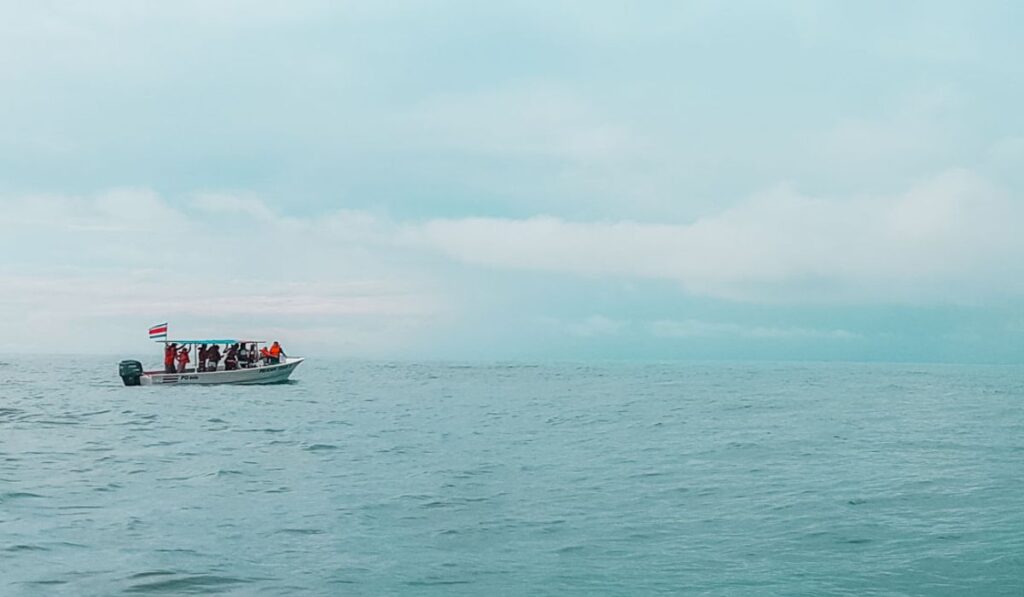
Until 1823, Costa Rica was part of the Spanish Empire. Under this rule, the flag was that of the Spanish Empire.
From 1823 until 1841 Costa Rica was part of the Federal Republic of Central America. Under this government, Costa Rica displayed the flag of the United Provinces of Central America. This flag took inspiration from the Argentinian flag.
The Federal Republic of Central America was unofficially dissolved by 1841. After that, Costa Rica based its flags on the Central American banner.
The first flag of Costa Rica consisted of two light blue horizontal stripes with a white stripe in the center. A coat of arms was in the center of the white stripe.
Then, on September 29, 1848, the First Lady Pacífica Fernández Oreamuno (wife of Costa Rican president José María Castro Madriz) recommended that a red band be added to the center flag and that the blue bands become darker. The white bands remained the same.
She was an admirer of the French Revolution and liked the symbolism associated with the colors of the French flag.
So, if you are familiar with flags you can see that Costa Rica’s flag is virtually the same colors as the French national flag.
Since her modifications, the Costa Rican flag has remained basically unchanged except for some modifications to the coat of arms. The current flag has a coat of arms that accurately represents the beauty and warmth of the country.
However, it is not unusual to see a Costa Rican flag without the coats of arms. This emblem is not always added to the flag.
The Symbolism of Costa Rica’s Flag
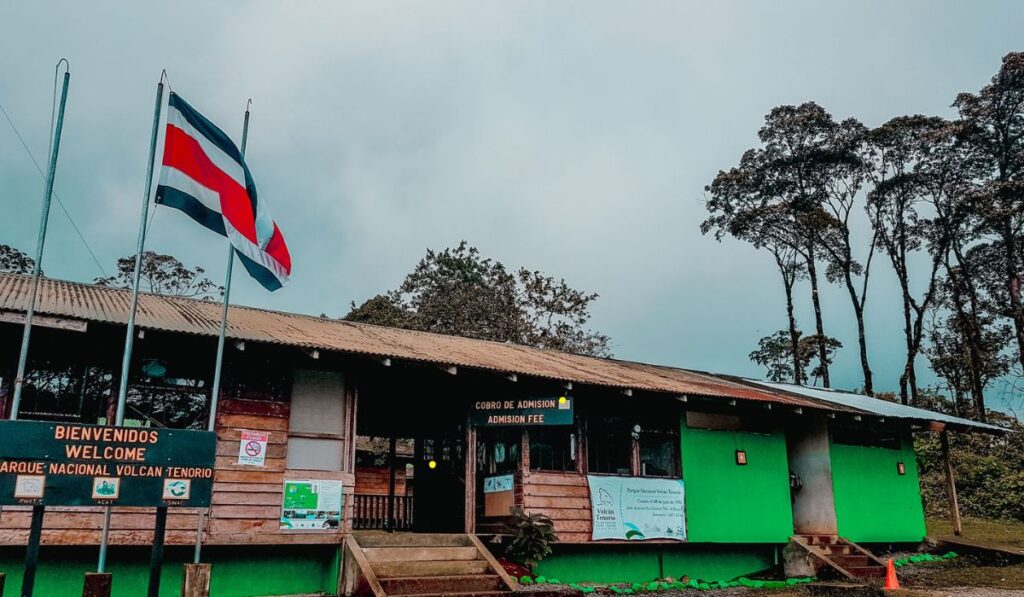
From top to bottom, the national flag of Costa Rican consists of five horizontal bands of color.
These are; a dark blue horizontal stripe, a white horizontal stripe, a large red center stripe with the national coat of arms located on the left side, another white stripe, and another dark blue stripe.
Each color of the beautiful flag of Costa Rica tells a story, deeply rooted in ideals similar to those of the French Revolution of 1848.
Think freedom, equality, and brotherhood.
Blue: This top and bottom stripe of blue stands for the the blue skies, endless opportunities, and intellectual pursuits.
It’s about striving to achieve goals and the vastness of the ideals, including spiritual and religious aspirations.
Blue is a nod to the country’s optimistic outlook and its commitment to intellectual and spiritual growth.
White: The white stripes signify clarity of thought, wisdom, and peace, which are central to Costa Rica’s identity.
It’s a color that also symbolizes happiness and the beauty of the sky.
White reflects the country’s drive for new initiatives and endeavors, underlining the importance of peace in Costa Rican culture.
Red: The broad central red stripe stands for the warmth and openness of the Costa Rican people, their love for life, and the sacrifices made in the pursuit of freedom.
Red also represents the generous attitude of the population and is a reminder of the sun’s rays that signify the dawn of Costa Rica’s independence.
Costa Rican National Emblem
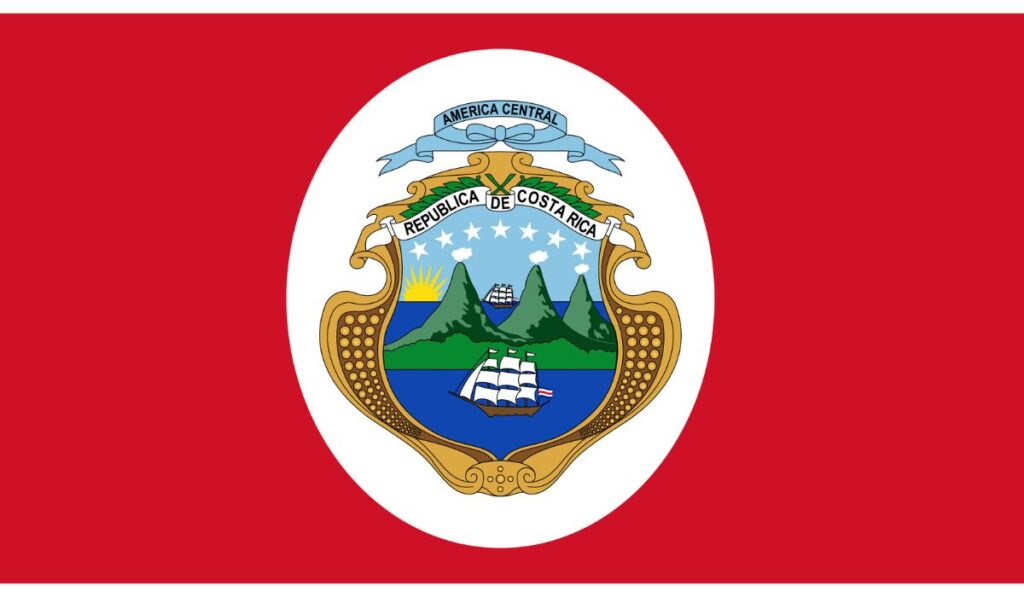
The national emblem of Costa Rica is a coat of arms that is rich in symbolism and reflects the country’s values, history, and natural beauty.
You can see the national shield in the center of the flag on the left side.
Here’s a detailed breakdown of its features and their significance:
Central Crest
At the heart of the emblem is a crest depicting three volcanoes with steam rising out of them and an extensive valley between two oceans.
The oceans represent Costa Rica’s position between the Pacific Ocean and the Caribbean Sea.
The volcanoes represent the country’s geographic landscape, which is dotted with mountain ranges and volcanic peaks.
Merchant Ships
On the oceans in the coat of arms of Costa Rica, there are merchant ships. These symbolize the maritime history of Costa Rica and its significance as a trading nation.
Seven Stars
Above the volcanoes are seven stars. These stars each represent one of the seven provinces that make up the Republic of Costa Rica. These are; San José, Alajuela, Cartago, Heredia, Guanacaste, Puntarenas, and Limón.
Rays of Sun
The sun’s face and rays shining above the crest symbolize prosperity and the nation’s bright future.
Myrtle Wreath
Encircling the crest are branches of myrtle, which is a traditional symbol representing victory and peace of Costa Rica.
Protocol and Usage of the Flag of Costa Rica

In Costa Rica, the national flag is treated with great respect.
It is flown on government offices, educational institutions, and at the entrance to all national parks.
The Costa Rican flag is also central to many national holidays and events, symbolizing unity and national pride. During Independence Day celebrations on September 15th, the flag is prominently displayed in parades and ceremonies across the country.
It also plays a significant role in sporting events, particularly in football matches, where it becomes a symbol of the country’s hopes and dreams.
There are specific protocols for its display and handling to ensure it is treated with the dignity it deserves. For instance, the country’s flag should never touch the ground.
When displayed alongside other flags, it must be in a position of honor.
These protocols are part of Costa Rica education. A sense of national pride and respect for national symbols are instilled from a young age.
Costa Rican National Symbols
Here are the national symbols of Costa Rica.
National Anthem
The original sheet music to the National Anthem of Costa Rica was written by Manuel Maria Gutierrez in 1852.
He wrote the piece in just three days. A national anthem was urgently needed at that time before the arrival of dignitaries from the United States.
The lyrics to the anthem were written by Jose Maria Zeledon Brenes. They were declared official in 1949 after a long series of alternative lyrics had been considered.
National Flower

Guaria Morada is the national flower. This is a beautiful purple orchid.
It was declared a national symbol in 1939.
Some people say it represents the beauty of Costa Rican women.
National Tree
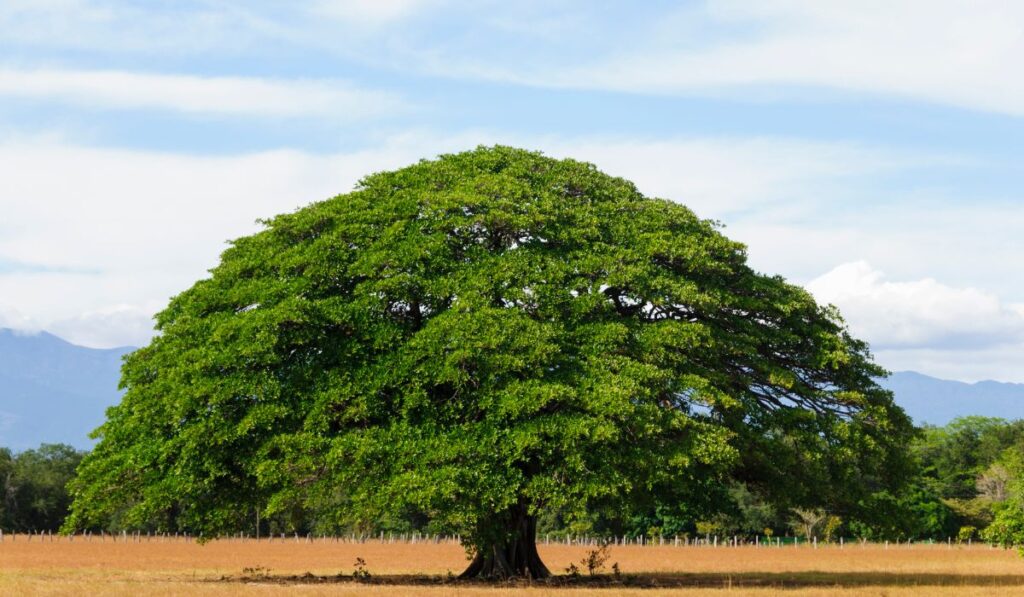
The Guanacaste Tree was declared as the national tree in 1959.
This tree has the same name as the northwest province in Costa Rica.
This was declared as a tribute to the province joining Costa Rica in 1825.
National Bird
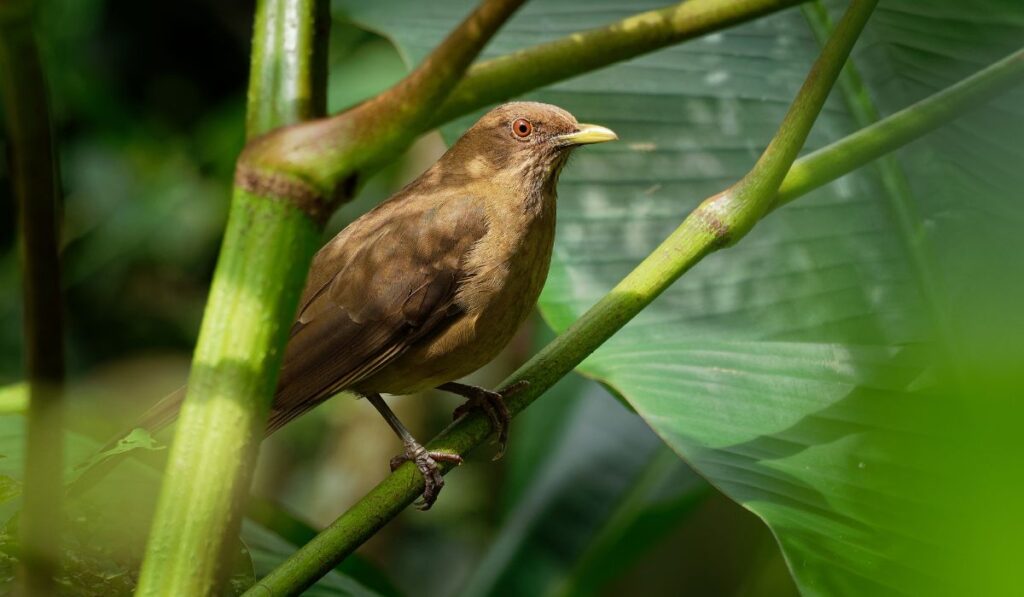
The Yiguirro was declared the national bird in 1976.
It is not as beautiful as some of the other amazing birds you might see in Costa Rica (like toucans and quetzals) but its call is one of the many important aspects of Costa Rica culture.
Every year, its song announces the coming of the rainy season.
National Symbol of Labor

The brightly painted oxcart was declared the national labor symbol in 1988.
During the 19th century, the oxcart was used as the main transportation tool for coffee plantations and trade.
Coffee beans are an integral part of industry in the country.
National Symbol of Wildlife

The white-tailed deer is the national symbol of wildlife. I know, this seems unusual for a country that has wildlife such as sloths and monkeys.
However, this deer species is in danger of extinction due to illegal hunting and natural habitat destruction.
Making it a national symbol of wildlife is intended to help preserve its habitat and curb hunting.
National Musical Instrument
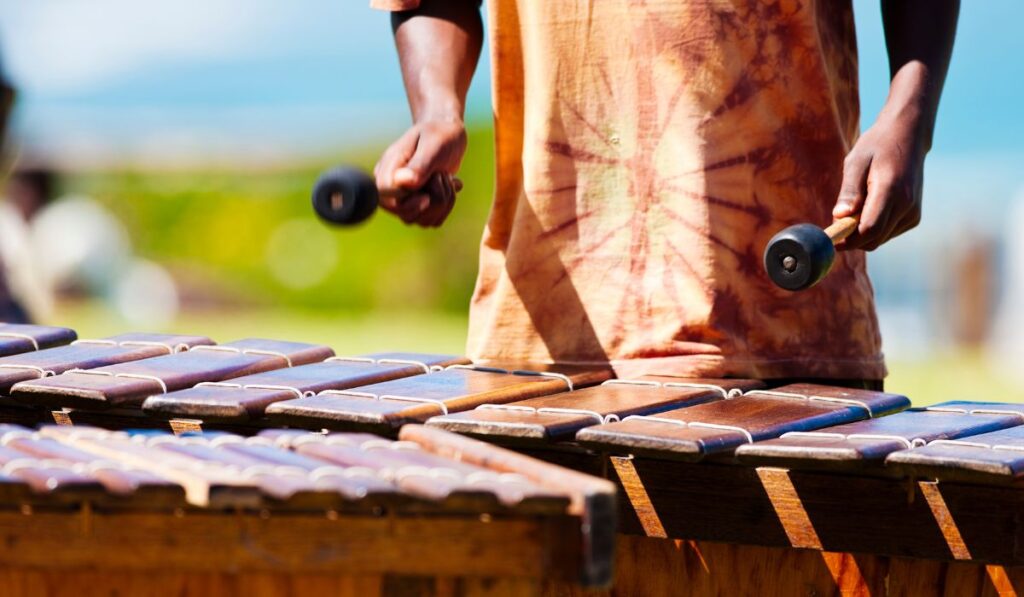
The marimba is the national instrument of Costa Rica. This instrument is often played in all Costa Rican celebrations and festivities.
Other Important Aspects of Costa Rican Culture
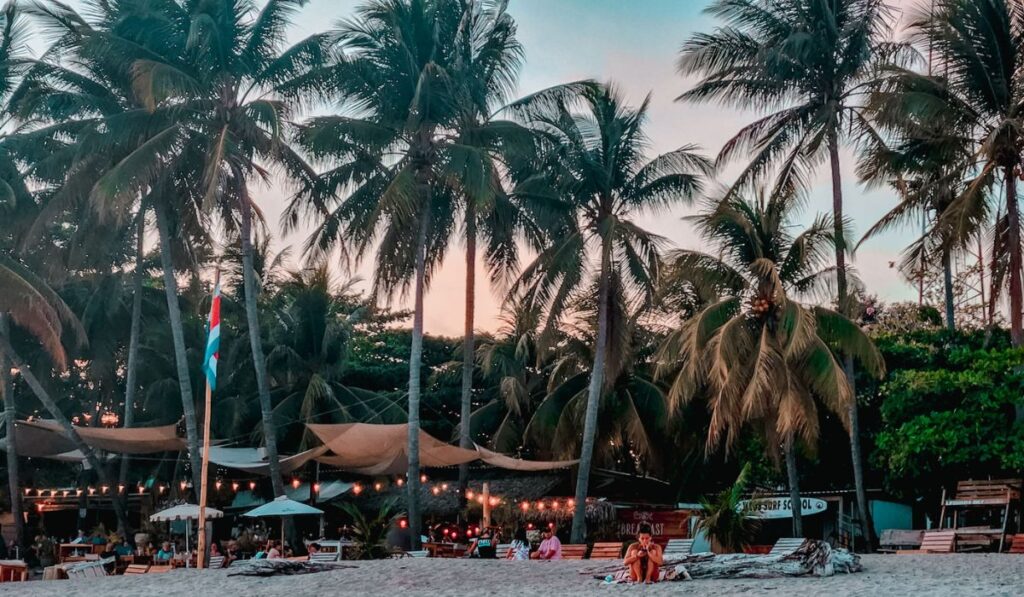
Pura Vida
Pura Vida is the motto for life in Costa Rica. As a direct translation into English it mean “pure life.” In Costa Rica it is used to mean that everything is good in life.
Costa Ricans are some of the most welcoming and happy people you will likely ever meet. This is a direct reflection to this relaxed attitude to life that is alive and well here.
Ticos/ Ticas
Costa Ricans are affectionately referred to as “Ticos” for men and “Ticas” for women.
No Military
Costa Rica does not have a military. The military was demolished in 1948. Instead, money that previously was designated for defense now goes into education.
The lack of military is a direct reflection of the peaceful and prosperous Central American country that Costa Rica is.
High Literacy Rate
Costa Rica is known for having the highest literacy rate in Central America. Around 98% of the population is literate.
Safety
Although petty theft is still a problem in Costa Rica, violent crimes are unusal. In general, this is a very safe country to visit and live in.
Conclusion: Costa Rica Flag Symbol and Meaning
In conclusion, the national flag of Costa Rican is a direct reflection of the beautiful and prosperous country that Costa Rica prides itself in being. The colors of the Costa Rica flag are the same as the colors of the French national flag as direct nod to the French revolution.
The flag, with its blue. white, and red color is a symbol that can be seen flying throughout the country and on many souvenirs, shirts, etc.
If you have any questions on the Costa Rica flag symbolism and meaning, don’t hesitate to leave them in the comment section below. We are always happy to help you out!
You Might Also Like:
Costa Rica Travel Details: What You Need to Know
🚗 Should I rent a car in Costa Rica?
Having a rental car will give you the most flexibility when traveling in Costa Rica. This will also allow you to take fun day trips on your own.
- Save 10% Plus Other Perks with Our Adobe Rental Car Discount
- You might also consider; shared shuttle services or private transfer services
🏄🏽 How can I book things to do?
We find that Viator tends to have the most comprehensive selection of activities with secure booking and good cancellation policies.
🍍 I’m overwhelmed with planning. Can you help?
Of course! I suggest joining our Facebook group for specific questions and head to our Start Here Page to get started planning.
✈️ What is the best way to book a flight?
Usually, we have the best luck finding great prices with Skyscanner. Check for flights to both San Jose Airport (SJO) and Liberia Airport (LIR).
🛏️ What is the best way to book my Costa Rica hotels?
We highly suggest Booking.com for hotel bookings and typically use VRBO for Costa Rica vacation rentals.
🗣️What is the main language in Costa Rica?
The main language in Costa Rica is Spanish. Most people working in tourism speak at least some English.
💰 What is the currency in Costa Rica?
The currency used in Costa Rica is the Costa Rican colón (CRC). However, the US dollar is widely accepted in most tourist areas
📞 What is the best way to stay connected?
An eSIM from Airalo is the easiest way to get 4G data while traveling in Costa Rica.
🌴 Is Costa Rica safe?
Generally, Costa Rica is considered safe for tourists. However, like any travel destination, it’s best to use caution and be aware of your surroundings.
🛂 Do you need a passport to go to Costa Rica?
Yes, Costa Rica is its own country. You will need a passport to visit.

Hi! We’re Thomas (the German) and Sarah (the US-er)
We met in Virginia, moved to Germany, and since 2016 we have lived in sunny Costa Rica.
It was a spontaneous decision to move here, but it was the best decision!
Now we spend our days roaming the country to bring you the very best in Costa Rica travel here on Costa Rica Vibes.
Sarah is the writer. Thomas is the one keeping it all together.
Want the whole crazy story?

Sarah McArthur
Sarah McArthur is the co-founder and main writer of Costa Rica Vibes.
She is originally from the United States but has lived in sunny San Jose, Costa Rica since 2016.
She has traveled all over the country and now considers herself a self-proclaimed Costa Rica travel expert.
Want the whole crazy story?

